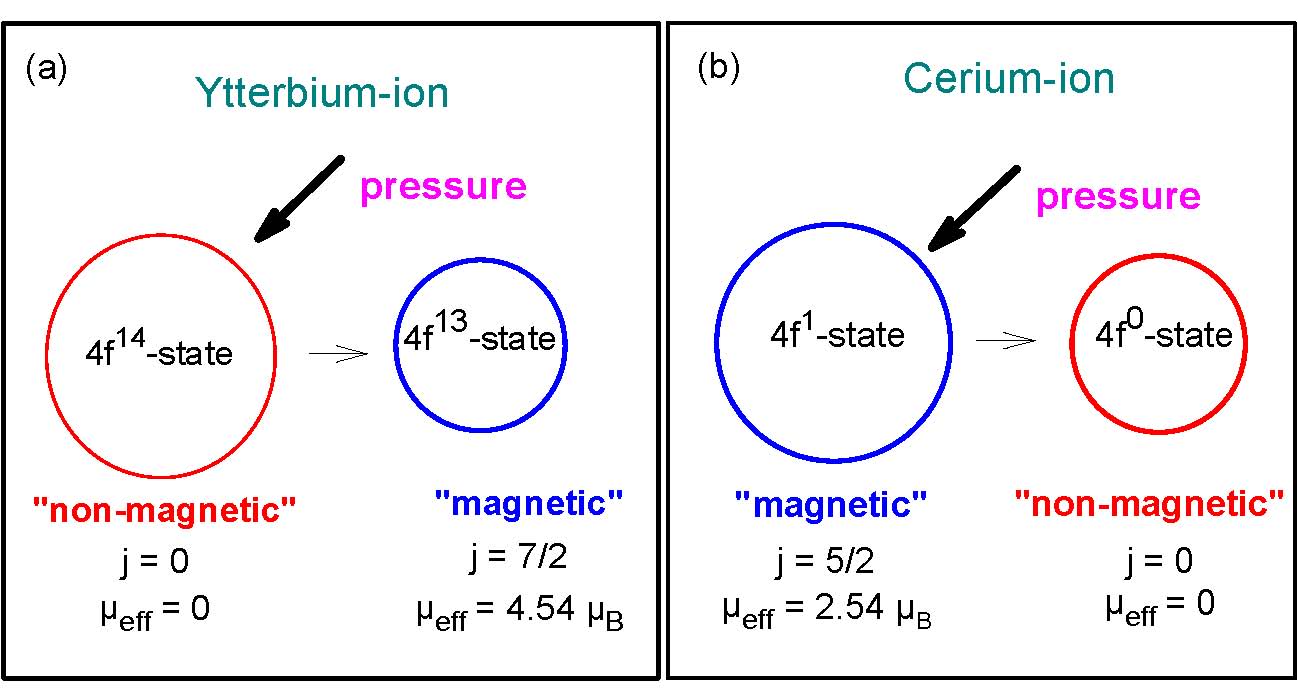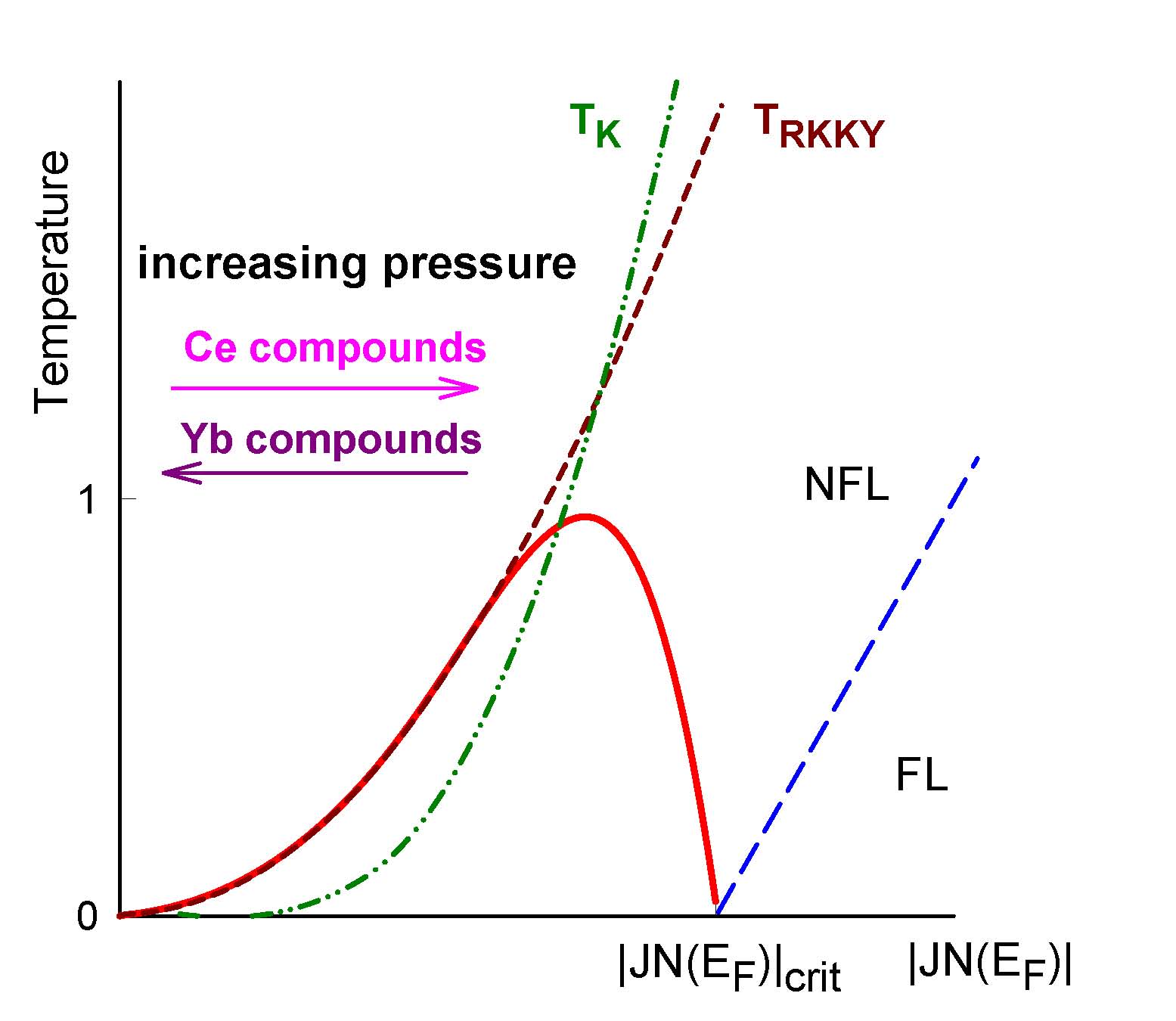Strongly correlated electron systems
Strong correlations between electrons (e.g., the interaction of conduction electrons with almost localised magnetic moments of 4f and 5f elements) can cause a number of outstanding and exciting low temperature features like unconventional superconductivity ("heavy fermion superconductivity"), insulating ground states ("Kondo insulator"), intermediate valence or magnetic ordering with significantly reduced magnetic moments.
The overwhelming number of these phenomena is found in cerium -, ytterbium - and uranium based compounds and alloys and may be referred to instabilities of the electronic configuration (EC) in the ground state. The principal interaction in such systems is, beside the RKKY interaction, the Kondo effect which tends to quench the local magnetic moments. For temperatures well below a characteristic temperature of the system (the "Kondo temperature TK") the physics of such systems can successfully be accounted for in terms of the Fermi-liquid model.
A central aspects of research of the group is the obvious symmetry between Ce and Yb compounds, originated from the respective 4f1 and 4f13 EC. There, the 4f1 electron of Ce behaves mirror-like to the one hole associated with the 4f13 EC. Most impressively, this follows from pressure applied to typical systems based on Ce and Yb. While magnetism is "suppressed" for the former, since the 4f1 electron is squeezed out of the 4f shell, the magnetic state is stabilised for the latter (compare figure 1) and non-magnetic systems can become magnetic by the application of pressure. This electron-hole analogy has been observed in many of such systems and was worked out in detail e.g., in both isostructural series CeCu5-xAlx and YbCu5-xAlx.
 | |
|---|---|
| Figure 1: A sketch of the pressure response of Ce and Yb ions | Figure 2: Doniach phase diagram of a Kondo lattice; note the different pressure response of Ce and Yb. |
A number of control parameters like substitution, pressure, magnetic field or valency allows to change the relevant interactions and thus the ground state of such systems. A variation of the s-f coupling constant times density of states, i.e., JN(EF) can drive the system from a magnetic towards a non-magnetic state (in the case of cerium systems this can be done by pressure) thereby passing a critical parameter where long range magnetic order is just suppressed to zero (compare figure 2). At that critical value of the parameter JN(EF) pronounced deviations from predictions of the Fermi-liquid behaviour occur, most prominent are a logarithmic contribution to the specific heat and deviations of the temperature dependent resistivity from a quadratic power law.
Theoretical understanding
The standard model of conduction electrons in metals presumes that the interaction among electrons can be described by a few parameters such as the effective mass which differs from the free-electron mass. This renormalisation leads to effectively independent quasiparticles that can be treated within the framework of Fermi-liquid theory. Even heavy-fermion systems - metals with a high concentration of rare-earth or actinide elements such as Ce, Yb, or U - can be regarded as Fermi liquids. The strong interactions between electrons in these materials lead to a very large effective mass m* derived from the huge linear specific-heat coefficient g = C/T and a correspondingly large Pauli susceptibility c, with C/T ~ c = const. at sufficiently low temperatures T.
Fermi-liquid Instabilities
Recently, striking deviations from the Fermi-liquid (FL) behaviour have been found in several heavy-fermion systems, e.g. C/T ~ -ln(T/T0). In some cases, a linear T dependence of the electrical resistivity is found instead of the T2 Fermi-liquid dependence. This non-Fermi-liquid (NFL) behaviour may have different microscopic origins such as the single-ion quadrupolar Kondo effect, a collective effect caused by the incipient antiferromagnetic order, or simply a distribution of Kondo temperatures arising from disorder. The scenario of incipient magnetic order is exemplified in CeCu6-xAux where concentration and pressure tuning are employed to reach the quantum critical point. In other cases such as CePd2Si2 or CeIn3 magnetism gives way to superconductivity upon approaching the critical point. 3d itinerant-electron systems such as MnSi and ZrZn2, as well as some further heavy-fermion systems, follow a behaviour that can be explained in terms of spin-fluctuations. U systems, on the other hand are often described within single-ion models.


